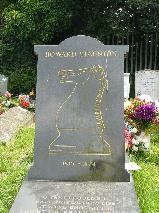Staunton, Howard |
| CHESS PLAYER, LITERARY MAN (ENGLAND) |
|
BORN 1810, London - DIED 22 Jun 1874, London CAUSE OF DEATH heart attack GRAVE LOCATION London: Kensal Green Cemetery, Harrow Road, Kensal Green (071/RS (24419), memorial erected in 1997) |
|
Howard Staunton appears to have been born at Westmoreland, but little of his early life is known and a birth certificate was never found. Possibly he was a natural son of Frederick Howard, fifth Earl of Carlisle. In 1836 he came to London where he supposedly became interested in chess after seeing Saint-Amant and George Walker play. In 1838 he played many games against captain Evans, who invented the Evans Gambit. He became chess editor of "British Miscellany" magazine and his turned his column into "Chess Player's Chronicle", which he edited until the 1850s. In 1843 he lost a match against Saint-Amant 3,5-2,5. Another longer match was staged in Paris and Staunton won 13-8 in December 1843. Saint-Amant wanted a revenge match, but Staunton suffered from heart trouble. In 1844 preparations for another match were made but then Staunton suffered from pneumonia and the match didn't materialize. In 1845 he started writing an influential chess column for the "Illustrated London News" and he continued doing this until his death. In 1847 he published "The Chess-Player's Handbook". In 1849 he married Frances Carpenter Nethersole, who already had eight children by her previous marriage. During the same year the famous Staunton chess pieces were introduced. In 1851 he organized the first international chess tournament in London. Staunton lost to Anderssen who won went on to win the tournament. He challenged Anderssen for a match but again he suffered from health problems and the match never took place. He played some more matches, but during the 1850s he was busy editing the text of Shakespeare, resulting in critically acclaimed publications between 1857 and 1860. There were talks about a match against American chess wonder Paul Morphy but after a lot of difficulties the project was abandoned. During the 1860s he spent most of his time writing about Shakespeare, although he continued his chess column. He died in 1874 in London and was buried at Kensal Green Cemetery. For many years his grave was unmarked, but in 1997 a new stone was erected by the Staunton Society. Related persons • wrote about Shakespeare, William |
| Images |
Sources • Howard Staunton - Wikipedia |



